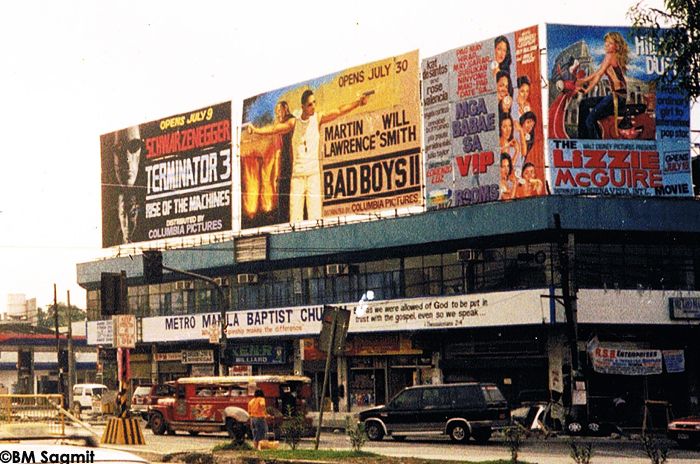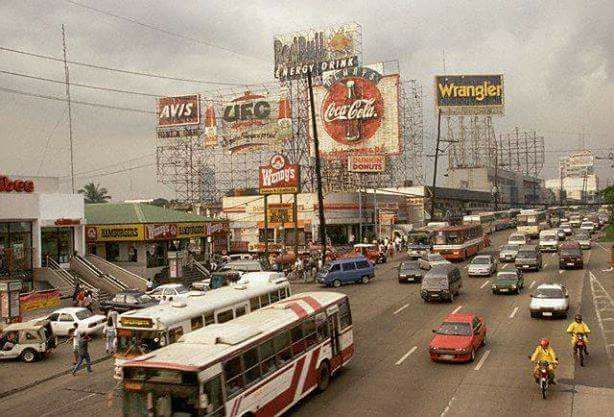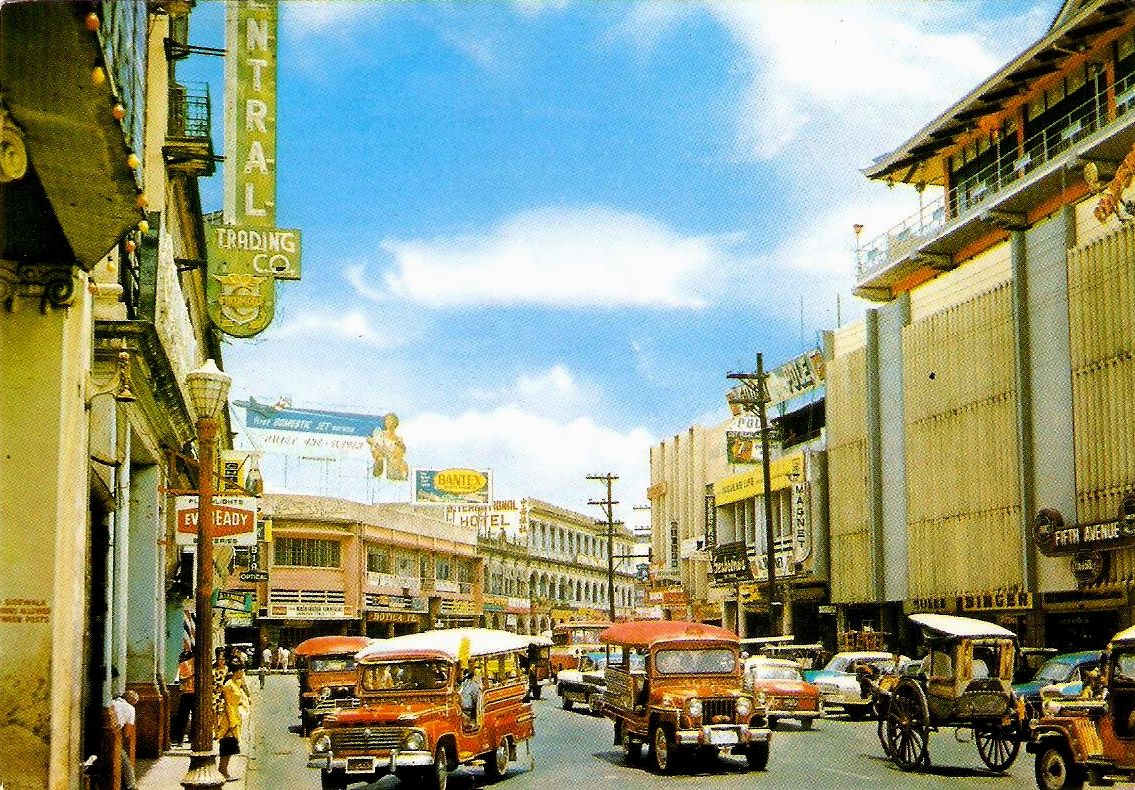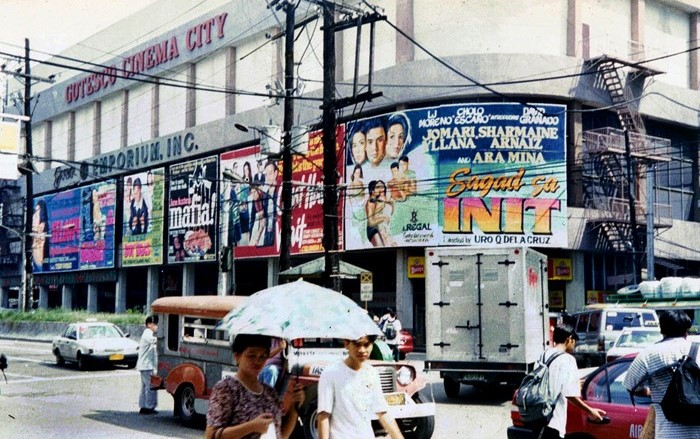When Art Met Advertising: The Forgotten Era of Hand-Painted Billboards in Metro Manila
“Original Ever Emporium”
I. Introduction — When Advertising Was a Canvas
In the haze and hustle of 1980s Metro Manila, the skyline wasn’t lit by pixels — it was painted by hand. Before digital screens and vinyl prints dominated the streets, advertising was an art form blending commerce and craft.
From the 1950s through the late ’80s, Filipino artists and sign makers transformed walls and billboards into monumental canvases for brands, movies, and commercial campaigns. Every brushstroke sold a story. Each hue was carefully chosen, rendered through human skill rather than machine precision.

Metro Manila Baptist Church. Photo by BM Sagmit via Pinterest
As chronicled by Ong (2022), the golden age of hand-painted movie billboards in the Philippines flourished across Avenida, Recto, Escolta, and Cubao — Manila’s old commercial arteries. Towering portraits of movie icons and smiling endorsers captured the attention of commuters. Layered meticulously with enamel paint, these murals reflected an era when advertising was both artistry and ambition.
Even beyond Metro Manila, cities like Cebu, Davao, Bacolod, Iloilo, and Pampanga saw similar creative efforts. Local brands leveraged hand-painted visuals to reach regional audiences, transforming provincial streets into open-air galleries of Filipino ingenuity.
II. Early Roots: From Painted Walls to Formalized OOH
Outdoor advertising in the Philippines stretches back to the early 20th century, when painted walls, signboards, and murals served as the city’s first storytellers. Before radio jingles, TV spots, or social media campaigns, these hand-painted visuals were the most visible and persuasive tools for brands and events, transforming public spaces into open-air theaters of commerce and creativity.
By 1964, fifteen pioneering companies — including Acme Neon Lights, Manila Neon Lights, Modern Advertising, Hi-Art Reproduction, and Universal Sales Promotions — founded the Outdoor Advertising Association of the Philippines (OAAP). Their mission: professionalize the growing industry, enforce a Code of Ethics, and legitimize outdoor advertising as a self-regulated, credible medium.
This formalization marked a turning point. Through the 1970s and 1980s, billboards transitioned from scattered signage to a coordinated industry. EDSA, Roxas Boulevard, Quezon Avenue, and provincial highways became canvases for creative expression and commercial strategy alike. Each billboard represented a marriage of artistry and enterprise, showing how Filipino painters translated brand messages into monumental visual statements.
III. The Golden Era: Techniques and Talent
Hand-painted billboards were a hallmark of Filipino creativity, combining skill, precision, and artistic vision. While specific studios or individual painters are not fully documented, historical accounts and interviews with retired sign painters provide insight into the typical methods used during the peak of this craft.

1990s Boni EDSA. Photo courtesy of Batang Blumentritt via Pinterest
Key practices included:
-
Color mixing for tropical durability – Enamel paints were blended to withstand sun, rain, and humidity, ensuring the artwork remained vibrant over time.
-
Layering and shading – Artists applied multiple layers of paint to create depth and dimension, making portraits and logos visually striking from street level.
-
Collaborative workflows – Large billboards were often painted by small teams working together, coordinating to maintain consistency across the entire canvas.
-
Attention to scale and perspective – Billboards had to be legible and visually correct for both pedestrians and motorists, requiring careful planning and execution.
These practices reflect the collective craftsmanship of the era, highlighting the patience, creativity, and problem-solving that Filipino artists brought to outdoor advertising. While the names of most studios and painters are not widely recorded, their work shaped Manila’s streets and regional cities into dynamic open-air galleries that captured the imagination of millions.
IV. Billboards Beyond Metro Manila

Iloilo City. Photo courtesy of Batang Blumentritt via Pinterest
While Manila was the hub of billboard artistry, regional cities embraced their own versions.
-
Cebu City: vibrant hand-painted ads along Colon Street and Mango Avenue promoted local cinemas and retail brands.
-
Davao City: billboards along J.P. Laurel Avenue featured film promotions and commercial campaigns for Mindanao-based brands.
-
Bacolod & Iloilo: provincial highways became gallery spaces for hand-painted visuals advertising consumer goods, festivals, and local cinema.
-
Pampanga & Angeles-Clark corridor: billboards targeting commuters traveling to Clark Airport were often colorful, large, and detailed.
This nationwide adoption highlighted the reach and influence of hand-painted OOH advertising, showing that Filipino artistry was not limited to the capital but spread across the archipelago.
V. The Transition: From Paint to Print
By the early 1990s, the industry began a rapid transformation. Large-format inkjet printing introduced tarpaulin billboards that could be produced in hours instead of days, offering cost efficiency and color accuracy essential for large-scale campaigns.
As Limbaga (2022) notes, the shift marked the rise of “high-tech large-format photographic prints, 3D inflatables, and large-screen electronic signage.” While this technology elevated precision and scale, it also led to the decline of hand-painted artistry.
Many billboard painters transitioned careers into:
-
Murals and street art
-
Sign-making and branding consultancy
-
Restoration projects for historical buildings and cultural sites
Despite the decline, the legacy of skill, creativity, and Filipino galing endured.
VI. Revival and Cultural Legacy
Nostalgia for hand-painted billboards has resurfaced.
-
2019: SM Cinema and Netflix Philippines recreated classic Filipino movie billboards to celebrate the centennial of Philippine cinema.
-
2024: The MMDA and iAcademy launched The Art of Billboard Project, where students and veteran painters recreated iconic movie posters along EDSA.
These projects highlighted not just history, but the Filipino flair and ingenuity embedded in every brushstroke. They reminded the public that advertising is storytelling, and that Filipino creativity thrives even within constraints.
VII. Reflection: Art, Memory, and Marketing
The era of hand-painted billboards shows that advertising is more than exposure — it is expression.
-
Each brushstroke carried creativity, patience, and diskarte — the Filipino knack for achieving impact with limited resources.
-
Billboards were cultural landmarks, not just sales tools. People recognized artists’ signatures in their style and composition.
-
Nationwide, cities like Manila, Cebu, Davao, Iloilo, Bacolod, and Pampanga all became stages for Filipino talent, merging local identity with global marketing standards.
Today, Firstboard Philippines carries forward this spirit: blending technology, precision, and creativity to produce outdoor campaigns that connect emotionally and remain memorable.
While the medium may have evolved — from brush to digital LED — the message remains proudly Filipino.
VIII. Bring the Artistry of the Past Into Your Next OOH Campaign
The era of hand-painted billboards proved that advertising works best when it feels crafted, human, and culturally rooted. Today’s DOOH may be digital, but the heart of great storytelling hasn’t changed — brands still win when their visuals spark emotion and stand out on the skyline.
If you want your next campaign to blend Filipino creativity, modern targeting, and high-impact visibility, Firstboard Philippines is ready to help.
Work with us to find the best billboard sites, secure competitive rates, and navigate prime locations across Metro Manila and the rest of the country.
Reach Firstboard today to start your campaign.
References:
Mejos, D. (2024, August 21). MURALS OF ICONIC MOVIE POSTERS TO LINE EDSA – MMDA — IKOT.PH. IKOT.PH.
Ong, W. A. (2022, July 7). The dying industry of hand-painted movie billboards. NOLISOLI.




